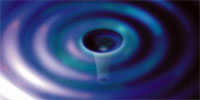Detecting nHz Gravitational Radiation using a Pulsar Timing Array
Detecting nHz Gravitational Radiation using a Pulsar Timing Array
Paul Demorest (NRAO), David Nice (Bryn Mawr), Ingrid Stairs (Univ. British Columbia), Scott Ransom (NRAO), Robsert Ferdman (Observatoire de Paris), Andrea Lommen (Franklin and Marshall), Don Backer (Univ. California - Berkeley), Marjorie Gonzalez (Univ. British Columbia)
 NANOGrav (North American
Nanohertz Observatory for Gravitational Waves) is a
multi-year project, which is seeking to detect gravitational
waves using the GBT (and the Arecibo Radio Telescope). This
is being done via the precise timing of a network of radio
pulsars. Pulsar timing is sensitive to GR with periods
comparable to the experiment duration (typically 1 to 10
years, or nanohertz frequencies). In this regime, the
radiation is expected to be dominated by the stochastic
background created by unresolved contributions from the
ensemble of massive black hole (MBH) binaries throughout the
universe.
NANOGrav (North American
Nanohertz Observatory for Gravitational Waves) is a
multi-year project, which is seeking to detect gravitational
waves using the GBT (and the Arecibo Radio Telescope). This
is being done via the precise timing of a network of radio
pulsars. Pulsar timing is sensitive to GR with periods
comparable to the experiment duration (typically 1 to 10
years, or nanohertz frequencies). In this regime, the
radiation is expected to be dominated by the stochastic
background created by unresolved contributions from the
ensemble of massive black hole (MBH) binaries throughout the
universe.




Connect with NRAO